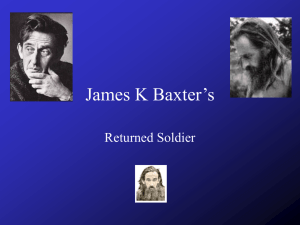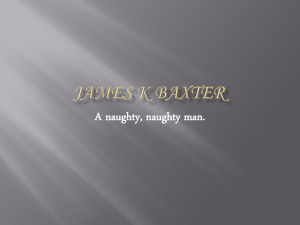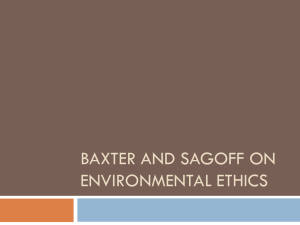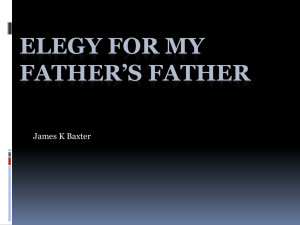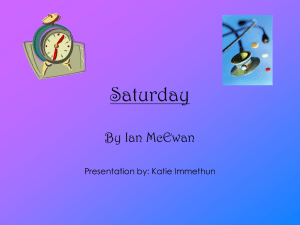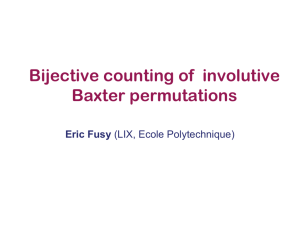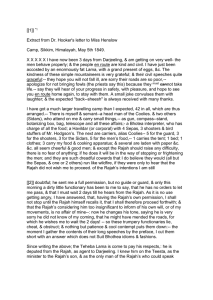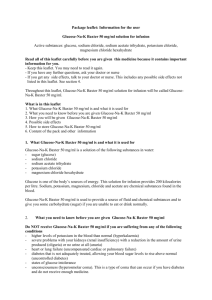SRL-Classroom-Scenar..
advertisement
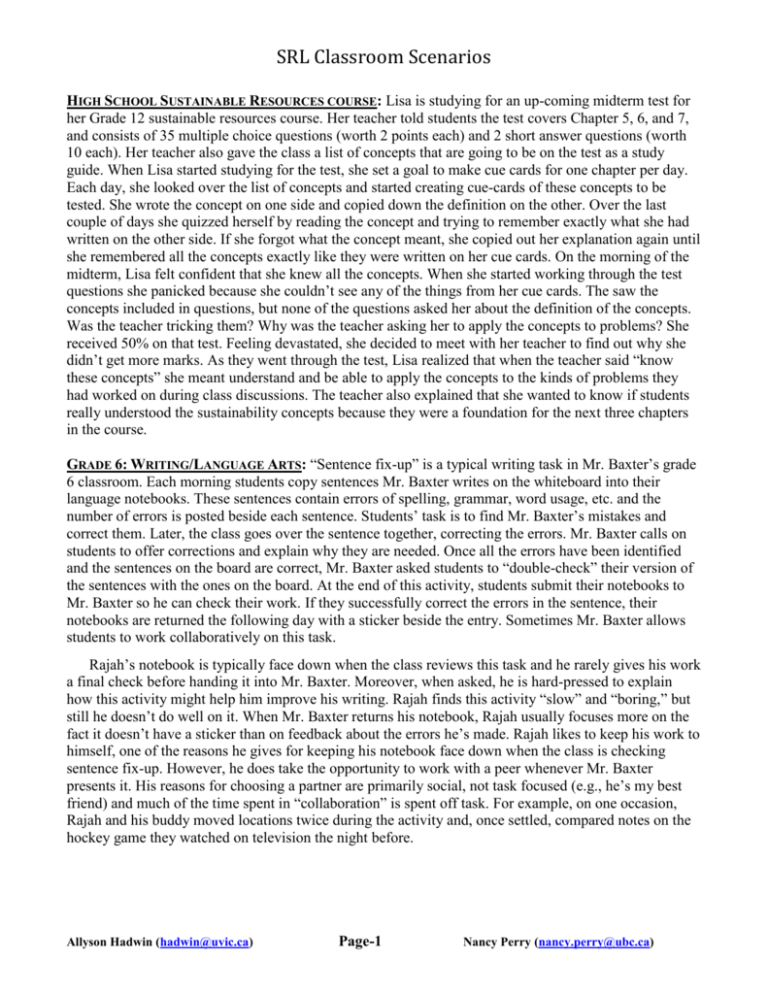
SRL Classroom Scenarios HIGH SCHOOL SUSTAINABLE RESOURCES COURSE: Lisa is studying for an up-coming midterm test for her Grade 12 sustainable resources course. Her teacher told students the test covers Chapter 5, 6, and 7, and consists of 35 multiple choice questions (worth 2 points each) and 2 short answer questions (worth 10 each). Her teacher also gave the class a list of concepts that are going to be on the test as a study guide. When Lisa started studying for the test, she set a goal to make cue cards for one chapter per day. Each day, she looked over the list of concepts and started creating cue-cards of these concepts to be tested. She wrote the concept on one side and copied down the definition on the other. Over the last couple of days she quizzed herself by reading the concept and trying to remember exactly what she had written on the other side. If she forgot what the concept meant, she copied out her explanation again until she remembered all the concepts exactly like they were written on her cue cards. On the morning of the midterm, Lisa felt confident that she knew all the concepts. When she started working through the test questions she panicked because she couldn’t see any of the things from her cue cards. The saw the concepts included in questions, but none of the questions asked her about the definition of the concepts. Was the teacher tricking them? Why was the teacher asking her to apply the concepts to problems? She received 50% on that test. Feeling devastated, she decided to meet with her teacher to find out why she didn’t get more marks. As they went through the test, Lisa realized that when the teacher said “know these concepts” she meant understand and be able to apply the concepts to the kinds of problems they had worked on during class discussions. The teacher also explained that she wanted to know if students really understood the sustainability concepts because they were a foundation for the next three chapters in the course. GRADE 6: WRITING/LANGUAGE ARTS: “Sentence fix-up” is a typical writing task in Mr. Baxter’s grade 6 classroom. Each morning students copy sentences Mr. Baxter writes on the whiteboard into their language notebooks. These sentences contain errors of spelling, grammar, word usage, etc. and the number of errors is posted beside each sentence. Students’ task is to find Mr. Baxter’s mistakes and correct them. Later, the class goes over the sentence together, correcting the errors. Mr. Baxter calls on students to offer corrections and explain why they are needed. Once all the errors have been identified and the sentences on the board are correct, Mr. Baxter asked students to “double-check” their version of the sentences with the ones on the board. At the end of this activity, students submit their notebooks to Mr. Baxter so he can check their work. If they successfully correct the errors in the sentence, their notebooks are returned the following day with a sticker beside the entry. Sometimes Mr. Baxter allows students to work collaboratively on this task. Rajah’s notebook is typically face down when the class reviews this task and he rarely gives his work a final check before handing it into Mr. Baxter. Moreover, when asked, he is hard-pressed to explain how this activity might help him improve his writing. Rajah finds this activity “slow” and “boring,” but still he doesn’t do well on it. When Mr. Baxter returns his notebook, Rajah usually focuses more on the fact it doesn’t have a sticker than on feedback about the errors he’s made. Rajah likes to keep his work to himself, one of the reasons he gives for keeping his notebook face down when the class is checking sentence fix-up. However, he does take the opportunity to work with a peer whenever Mr. Baxter presents it. His reasons for choosing a partner are primarily social, not task focused (e.g., he’s my best friend) and much of the time spent in “collaboration” is spent off task. For example, on one occasion, Rajah and his buddy moved locations twice during the activity and, once settled, compared notes on the hockey game they watched on television the night before. Allyson Hadwin (hadwin@uvic.ca) Page-1 Nancy Perry (nancy.perry@ubc.ca) SRL Classroom Scenarios GRADE 2/3: RESEARCH ABOUT ANIMALS: Students in ‘Laura’s’ grade 2/3 class are doing research about animals. They are preparing a written research report about an animal of their choosing. ‘Carol’ is illustrating a picture to go in one section of her report. She considers the challenges this project has presented for her. First, she has chosen a difficult topic, tigers, “because [tigers] are difficult to find … there is not that many books that have tigers in them.” Typically, information about tigers is embedded in books about “all kinds of different animals,” so she needs to learn how to “look through the whole book … [and use the table of contents].” Second, Carol is finding it difficult to transform the ideas on her web outline into sentences for her report. “Making up the way they should go is kind of hard … because there are many ways and sometimes … you don’t know which way to put them.” To cope with these difficulties, Carol teams up with a classmate who is studying cougars “because cougars and tigers are in the same family.” Her buddy helps her to “understand things,” and helps her with her writing. Carol is confident having this help will enable her to cope independently and effectively with the challenges researching and writing present. Also, as she writes, she underlines words she thinks are misspelled so she can check them later when she meets with Laura to edit her report. Unlike many lowachieving students, Carol is not afraid to attempt challenging tasks, and she is confident about her ability to develop as a writer. Reflecting on her progress across the school year (see Figure 1), she thinks, “I learned a lot from when I was in grade 1 because I had a lot of trouble then.” GRADE 8 ENGLISH TASK: “Fiona was working on the 2nd in a series of 3 inquiry projects focusing on identity and sense of self. Building on an early project about what she had learned about herself through past life experiences, the 2nd inquiry project required students to explore and demonstrate their understandings of “identity”. Two short stories were studied to explore the idea of whether a person can change their identity or just discover it more deeply. Students were required to construct a commentary (narrative, film, cartoon strip, storyboard, or mind map) to show factors that might influence identity, including family and friends, acts of courage, accidents and illness, significant life events, media and perceived intelligence.” (Prain, V. (2008, November). A case study of self-regulated learning in junior secondary English. Paper presented at the Australian Association for research in Education Conference, Brisbane, Australia (PRA081038) . Fiona tried to get started on this assignment. She wanted to make the most of the two 2-hour inquiry class timeslots per week. For the first 2 inquiry periods, Fiona’s goal was to “read the short stories.” She sat down to read. The first story was really interesting. It reminded her of her summer vacation last year and she found herself day- dreaming about the vacation. When the time block finished, Fiona had not finished the first story. In the second class period she set a goal to finish both short stories. She found herself having trouble paying attention to the details in the story and regularly checked the clock to see if the 2 hours was over yet. By the end of class she had read only the first story. She kept putting off reading the second story, realizing that she wasn’t feeling very motivated. The next week, Fiona planned to make an outline for her storyboard so she could get started on the project. She wasn’t feeling very confident that she knew what a storyboard. A friend pointed out that the class had made a storyboard together last month (it was posted on the class bulletin board). After reviewing that map, Fiona created 10 frames to capture the main events in the story. Over the next couple of weeks she sets to work creating her own story board for a short story. She decided to focus on the first short story since that is the one she really liked. As she prepared for her first inquiry project progress meeting with the teacher she felt very confident that the teacher will be thrilled with her storyboard and her timeline. About 3 minutes into their meeting, the teacher asked how this story line drew on the concepts of “identity” developed in her first inquiry project? The teacher suggested that rather than creating a storyboard for the narrative aspects of one short story, she should create a story of her own that illuminates factors that contribute to identity. Allyson Hadwin (hadwin@uvic.ca) Page-2 Nancy Perry (nancy.perry@ubc.ca)


